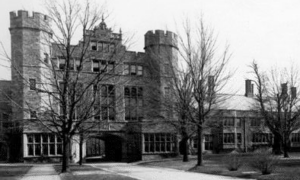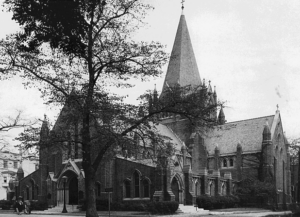Title: Builder, contractor
Birthdate: August 12, 1834
Death Date: July 25, 1904
Plot Location: Section 30, Lot 14, southeast part

Henry’s parents had ten children in their native Germany, but five of them didn’t survive past their first year. The family left the past behind when they immigrated to Lancaster County, Pennsylvania in 1832. Henry became their 11th and last-born child two years later.
Assimilation was not as difficult for them since that area had a large Germanic population. Henry’s oldest brother anglicized his surname from the original Gfrörer to Gefrorer. The rest chose to use Frorer except for brother Fred who spelled his name Froerer.
In 1848 Fred upset the family’s religious tradition by joining a group of “Latter Day Saints.” He journeyed with them to Utah where he lived the rest of his life. The family was already upset by the loss of Henry’s father that same year; then his mother decided to uproot the family to Philadelphia. In the midst of all this, Henry ended his formal education. He became an apprentice at a construction company in the city known as “Lanning & Sill.”
His mother passed away in 1853, leaving 19-year-old Henry to live with his sister, Louisa, who was eight years older. Henry was an avid reader, so he learned both the theory and practice of building construction, which became his passion for life.
It was another nine years before his romantic passion led him to marry Philly native Catherine Charlton. They were married in the Spring Garden neighborhood, where they called home for the next 30 years. They brought forth three boys: Robert in 1865, Henry in 1867, and Thomas in 1871. Thomas succumbed to a disease in 1876 and was the first to be buried at Mount Moriah..
No information was available about the buildings Henry worked on in his early years. He probably didn’t become a contractor until later; the city directories and the census in both 1870 and 1880 listed his occupation simply as a carpenter. He may have moved up to foreman shortly thereafter. Whether he worked on his own or for someone else, his success in business made it possible for the Frorers to move to the “Main Line” in 1891.
During the “Gilded Age” of the late 1800s, Philadelphia’s wealthiest families built sprawling estates northwest of the city toward Villanova and Malvern, becoming a bastion of “old money.” Transportation was convenient thanks to the Pennsylvania Railroad’s “main line” which originally referred to the tracks running west to Harrisburg and Pittsburgh. The upper-class suburbs later spawned new subdivisions that ran parallel to Lancaster Avenue (Route 30).
Henry’s new home was in the Bryn Mawr area that straddles Delaware and Montgomery  counties. He not only lived there, he built this castle-like Pembroke Hall dormitory on the campus of Bryn Mawr College. He also constructed the first building to house the new Bryn Mawr Hospital.
counties. He not only lived there, he built this castle-like Pembroke Hall dormitory on the campus of Bryn Mawr College. He also constructed the first building to house the new Bryn Mawr Hospital.
Some locally famous clients had him build “summer homes” for them in nearby Radnor. One was for George Childs who co-owned the Philadelphia Public Ledger, one of the city’s major daily newspapers. The “country estate” shown here was built for Lincoln Godfrey, a prominent financier and a director on the board of the Philadelphia National Bank and the Pennsylvania Railroad. Another one of Henry’s more distinguished projects was the St. Thomas Episcopal Church in Washington, D.C., shown below.
was built for Lincoln Godfrey, a prominent financier and a director on the board of the Philadelphia National Bank and the Pennsylvania Railroad. Another one of Henry’s more distinguished projects was the St. Thomas Episcopal Church in Washington, D.C., shown below.
In 1895, while still building the church, Henry bought the 106-acre Maple Croft Farm near King of Prussia to enjoy his last years. On the 1900 census he listed himself as a farmer. Henry Jr. died that year and was buried with his wife’s family in Chester County. The last surviving son, Robert, was living on his parents’ farm with his wife and children, but he died less than two years later.
An “obstruction of the liver” took Henry’s life in 1904. The next year his sister Louisa died and was buried next to the youngest son, Thomas. After Catherine died in 1919 the children of Robert and Henry Jr. had her laid to rest beside Henry, creating this row of four identical, simple gravestones. Robert’s grave is in this same lot but his stone has not been found.


Support the Friends of Mount Moriah
Help us in our mission to restore and maintain the beautiful Mount Moriah Cemetery by donating to our cause or volunteering at one of our clean-up events.

